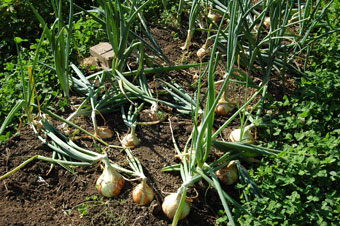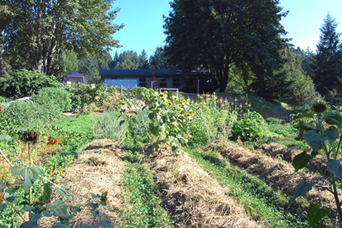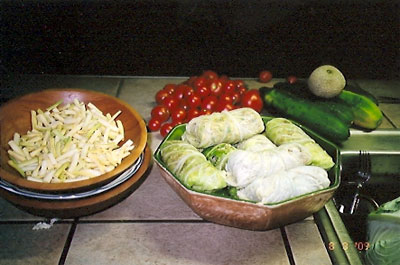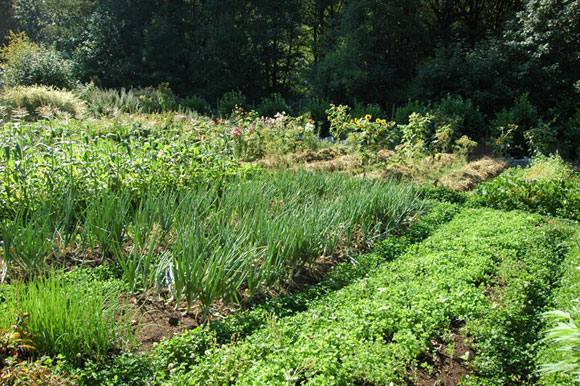
GETTING THE MOST OUT OF THE LAND
Many people have responded to concerns about peak oil by trying to minimize their dependence on petroleumóboth as a personal statement and a desire for self-reliance. Some change their diet, giving up meat. Some park their car and rely on a bicycle for transportation. Some, just as worried about climate change, monitor their carbon footprint. But more and more, we have heard of people moving out onto a piece of land and, often with little or no previous experience, diving into the task of growing and processing their own food. There is a sense of romance to this effort, managing a plot of land, raising chickens or goats, unplugging from the grid as much as possible.
The reality of the matter is that it's incredibly difficult to live off subsistence farming and takes far more work than anyone that hasn't tried it would imagine. David and Elaine Kost, who live outside Junction City about fifteen miles from Eugene, embarked on this adventure seven years ago. While on one hand, they have gotten very good at this kind of living and are remarkably productive, as can be judged by the amount of food they were able to store for the winter of 2009-10, they have also learned how hard this can be and how much time is involved. Below, Elaine sums up the couple's experience living off the land and their effort to have others join them.
My husband, David, 53, and I, Elaine, 51, have been married for 32 years and to date, growing and preserving our own food has been one of the most valuable yet difficult struggles we have endured. Growing food in a rural setting is much different than the life we grew up in. Both of us were raised in the city and didn't pay much attention to where our food came from. It wasn't until our first home-grown tomatoes that we realized how different the color and taste was.
Our home is on five acres just west of Junction City, Oregon. The land was nothing more than overgrown scrub and scotch broom. Initially we had excavation work done and also used our small 20-HP Kioti tractor to work the soil and build our raised beds. Amended with tons of mint compost, rabbit and chicken manure as well as garden compost and leaves, we have managed to build up the soil. By using cover cropping and crop rotations we keep the weeds under control and have used no sprays or chemicals. For the last three years, we haven't even tilled.
Our hobby garden has become a small productive farm where we raise enough food to eat what's in season as well as process what's left over. We have found that preserving what we don't consume right away has saved us money on our food bill and allowed us to be creative with our recipes throughout the year.


Though the work is intense and physically challenging, the rewards far outweigh the aches and pains. Up until I retired a year ago, my husband did most of the work himself. During the busy summer months, he often worked 60 hours or more a week. Half of this time was used for drying, canning and freezing.
We thought when we started to farm, we would be able to entice another like-minded couple to live on the property and share living expenses as well as build on what we've started. Sharing the work would allow us to spend time on developing other ways of generating income as well as enjoying our spare time. But it has been almost as difficult to find proper co-operative partners as to work the farm. Too often, the people we have interviewed come with no financial reserves at all or any real insight into the amount of work and determination necessary to take part in such an enterprise. Too many want the idyllic lifestyle without the commitment. And for us, both over fifty years-old now, without another hand or two, it will be difficult to maintain. This is an important insight into the prevailing culture and its dependence on petroleum. Most of us overlook how much work petoleum really does for us and what it would take to live without.
Food Storage 2009
All the food that is listed below was produced on the Kost farm in raised beds, using cover cropping, compost, and crop rotations in a 100 foot by 85 foot plot. There was no tilling. There were no chemicals, and David and Elaine did all the food processing.
| Dried |
Canned |
Frozen |
Cool Storage |
Herbs |
| 50 qts tomatoes |
9 pts pickled veggies |
20 - 4 packs of corn on the cob |
155 lbs potatoes |
1 gal apple mint |
| 22 qts zucchini |
12 qts butternut squash |
20 - 8 packs of stuffed cabbage |
200 lbs onions |
1 pt spearmint |
| 5 gal red onions |
7 qts sweet meat squash |
16 - 1.5 qts spagetti squash |
600 heads of garlic |
1 pt orange mint |
| 8 qts strawberries |
7 qts pumpkin |
5 gal blueberries |
30 spaghetti squash |
2 qts peppermint |
| 8 qts anaheim peppers |
25 qts grape juice |
5 gal marionberries |
12 butternut squash |
1 gal mugwort |
| 3 qts celery |
25 pts strawberry jam |
3 gal boysenberries |
8 sweet meat squash |
1.5 gal motherwort |
| 4 gal celery leaves |
12 qts blackberry jam |
3 gal strawberries |
4 pumpkins |
1 gal yarrow flowers |
| 1.5 qts Eur. Soldier Beans |
12 pints boysenberry jam |
20 - 10 packs anaheim peppers |
- |
.5 gal lavender |
| 2 qts Swed. brown beans |
22 qts sauerkraut |
8 pts pesto |
- |
1 qt lemon balm |
| 1 qt scarlett runner beans |
48 qts tomato sauce |
50 lbs walnuts (bought/shelled on farm) |
- |
4 qts lemon verbena |
| 8 ristras (50-100 peppers) |
14 qts salsa |
- |
- |
3 qts pineapple sage |
| - |
16 qts pickles |
- |
- |
4 qts basil |
| - |
58 qts green beans |
- |
- |
1 qt clarey |
| - |
- |
- |
- |
1 qt rosemary |
| - |
- |
- |
- |
3 qts calendula flowers |
| - |
- |
- |
- |
2 qts skullcap |
| - |
- |
- |
- |
1 pt dill seed |
| - |
- |
- |
- |
1 pt lemongrass |
STILL IN THE GARDEN: (1) 4 foot by 20 foot bed of turnips and rutabagas, (2) 4 foot by 26 foot beds of brassicas, (1) 4 foot by 18 foot bed of mixed lettuce, spinach, cilantro, and green onions, (1) 4 foot by 18 foot bed of Swiss Chard and Kale.





